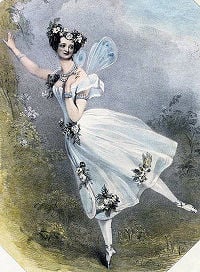Marie Taglioni
Marie Taglioni (April 23 1804 – April 24 1884) was a famous Italian ballerina of the Romantic ballet era, a central figure in the history of European dance. Despite the fact that she was not a great beauty, Marie's delicacy and finesse brough her much fame in the dance world. In 1822, Taglioni made her debut as a dancer in Vienna. However, it wasn't until her starring role in La Sylphide, a romantic ballet choreographed by her father, did she become famous throughout Europe. Although she wasn't the first to dance on pointe, she was the first to do so for the entirety of a performance. She perfected the technique using ballet slippers - not toe shoes - which without reinforcement in the block of the shoes was incredibly difficult. Dancers had to use all of their muscles to stand on pointe.
Biography
Born in Stockholm, Sweden, Marie Taglioni rose to fame as a dancer when her Italian father (and teacher) Filippo Taglioni created the ballet La Sylphide (1832) for her. Designed as a showcase for Marie's talent, it was the first ballet where the ballerina danced en pointe for the full length of the work.
Marie Taglioni was the first star of the romantic ballet era.
She left the Paris Opera Ballet in 1837 to take up a three-year contract in St. Petersburg at the Mariinsky Ballet (known as the Kirov Ballet through most of the 20th century). It was in Russia, after her last performance in the country (1842) (and at the height of the cult of the ballerina), that a pair of her pointe shoes were sold for two hundred rubles, reportedly to be cooked, served with a sauce and eaten by a group of balletomanes.
Marie retired from performing in 1847. For a time she took up residence at the Ca d'Oro on the Grand Canal in Venice. When the ballet of the Paris Opera was reorganized on stricter, more professional lines, she was its guiding spirit. With the director of the new Conservatoire de danse, Lucien Petipa and Petipa's former pupil the choreographer Louis Mérante she figured on the six-member select jury of the first annual competition for the Corps de ballet, held April 13, 1860.
Later she taught social dance to children and society ladies; she also took a limited number of ballet pupils. Her only choreographic work was Le Papillon (1860) for her student Emma Livry, who is infamous for dying in 1863 when her costume was set alight by a gas lamp (limelight) used for stage lighting. Marie lived much longer, dying in Marseilles in 1884.
Johann Strauss II composed the Marie Taglioni Polka (Op. 173) in her honour using music from ballets in which she had appeared.
- [1] Marie Taglioni - the first woman to dance on pointe.
Credits
New World Encyclopedia writers and editors rewrote and completed the Wikipedia article in accordance with New World Encyclopedia standards. This article abides by terms of the Creative Commons CC-by-sa 3.0 License (CC-by-sa), which may be used and disseminated with proper attribution. Credit is due under the terms of this license that can reference both the New World Encyclopedia contributors and the selfless volunteer contributors of the Wikimedia Foundation. To cite this article click here for a list of acceptable citing formats.The history of earlier contributions by wikipedians is accessible to researchers here:
The history of this article since it was imported to New World Encyclopedia:
Note: Some restrictions may apply to use of individual images which are separately licensed.
